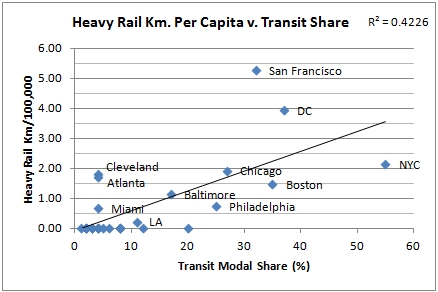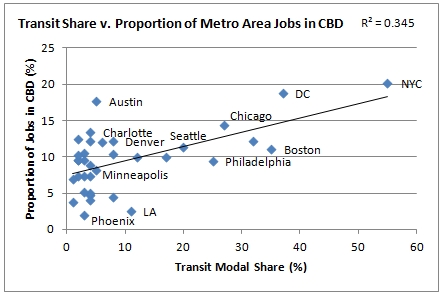Back in 2010, Nathan Lewis
published what is one of the few pro-urban critiques of transportational bicycling available on the net. In the piece, he calls into question the assumption that increasing rates of urban bicycling, or increased provision for bicycle infrastructure, are necessarily beneficial for pedestrian-centric traditional urbanism.
One of the greatest dangers, Nathan writes, is that a city consciously designs itself around the bicycle, while neglecting the needs of people on foot. It is not a groundless concern: the blog
Half the Fun critiques (with photos) the Dutch city of Houten, which was designed entirely around bicycles, for having "lost sight of the forest for the trees" by its focus on cycling rather than on "creat[ing] better, more livable communities."
The article concedes that "more bikes on the road would lessen just about every transportation problem you can
 |
A growing storage problem: bicycle parking by a transit
station, Copenhagen (Leif Jørgensen). |
think of," but I think that is true only where a new bike trip replaces a trip by car. Replacing a walking trip or a transit trip is less obviously beneficial from a citywide perspective, since the bicycle introduces potential conflicts with pedestrians and presents parking issues that differ only in scale from those of cars. A review of European transportation initiatives, however, shows a frequent focus on increasing bicycle use and modal share, rather than simply decreasing automobile share, with the unstated assumption that the added bicycle riders will be drawn largely or exclusively from the pool of car drivers.*
That may not always be the case. Although evidence isn’t abundant, one study in the Danish city of Odense found that, during the mid to late-1990s, although the share of all trips taken by bicycles rose from 22.5 to 24.6%, this was
accompanied by decline in the share of public transportation from 8.2 to 6.6%. By contrast, in Portland, a
recent increase in bicycling share appears to have been drawn at least as much from the driving population as from transit riders. This question of whether increased funding for bike infrastructure indirectly results in the decline or stagnation of a city's own transit ridership should be of interest to municipal transportation agencies.
Based on commuting modal share statistics, it is not always easy to tell the extent to which new cycling trips have displaced transit and walking trips, car trips or both. Consider the dramatically different commuting mode shares of four European cities, each of which has taken a somewhat different approach toward transportation, while all having near-identical rates of car commuting:

On first glance, it's not easy to explain the differences between cities like Copenhagen and Vienna. Both are national capitals of similarly sized countries with similar metro populations and mass transit networks that include extensive subway systems. Vienna is denser than Copenhagen, which may in part explain the much higher walking share, but we see that despite Copenhagen's immense pro-cycling efforts (so extensive that they have given their name to a popular
pro-bicycling movement), its car share is only slightly less. Vienna, by contrast, has a much more modest goal of
increasing bike share to eight percent, but has primarily focused on
improving transit share.
In fact, the results over time for both cities show that transit share hasn't budged, even though
Copenhagen's metro entered service in the middle of the time period below (Vienna's
U-Bahn has undergone recent expansion but much of the system, which opened in 1976, predates 1993). Is it possible that pro-cycling efforts siphoned off potential transit riders in Copenhagen? And if so, was this beneficial for the city?
Vienna met its own earlier cycling share goals, but even more significant was the increase in walking share, which far exceeded expectations even though walking is hardly mentioned in Vienna's 1993 transport
agenda. What Vienna had in abundance, after all, was dense, traditional urbanism
– the ultimate pedestrian infrastructure. Through restrictions on cars, the city streets again became pleasant places to be, inducing walking far more than expected. Copenhagen implemented similar policies, yet saw a decline in its already low walk share.
Still, it is difficult to be too critical of increased bicycle use. By the standard of almost any American city, Copenhagen's achievement in reducing modal share for cars is remarkable. The bicycle, too, is an almost magical technology, the sole transportation method devised by man which has
improved on the energy efficiency of walking, and one which expands the range of choices for city dwellers.
But is it enough to consider the impact of bikes on the natural environment? Shouldn't their cumulative impact on the urban environment be considered as well? This will involve issues not only of parking ever-larger numbers of bikes as their popularity grows, but of compatibility with walking and mass transit, and of a city's vision for the interaction between the various modes of urban transport.
One final mode share chart, for New York:
The cycling share may seem surprisingly low, but consider what a bicycle is worth in the city: although it may improve mobility as compared to walking alone, it also essentially locks the bicyclist out of New York's entire public and private transit system (MTA and taxi service), all of which is implicitly designed around the person on foot (sure, there is the
Metrobike and other folding bikes, but their appeal is limited and practical difficulties remain). With the transit system running 24 hours a day, even the ready availability of the bicycle ceases to be an advantage.
All this suggests that as a city's mass transit system improves its frequency, coverage and hours, the value of a bicycle for urban mobility should decrease until, in the case of New York, it reaches close to zero for many neighborhoods. There's room for difference of opinion, but I think this must be seen as a good thing. Bikes can be an excellent transit gap-filler, in limited number, but may not be as well suited to being the central element of a transit strategy.
*See e.g.
Copenhagen ("it is municipal policy that cycling mode share should go up to 40% by 2012 and 50% in 2015");
Groningen (city "promot[es] cycling as the main mode of transportation" with "vast expansion of the cycle network");
Charter of Brussels: (cities pledging to "set of target of at least 15% for the share of cycling in the modal split of trips for 2020").













